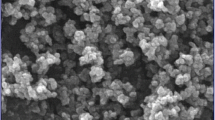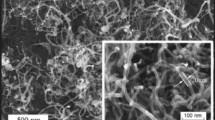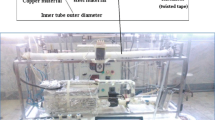Abstract
The present study’s goal was to investigate the efficiency of applying carbon/water Nanofluid and triangular baffles in the double-tube heat exchangers. The Reynolds number was in the range of 4000 to 14,000, and the carbon/water Nanofluid, which was with various volume fractions ranged between 0.1 and 0.3 volume percentages, was applied. Moreover, triangular baffles were implemented as turbulators with the numbers of 4, 8, and 12, as well as angles of 70\(^\circ\) and 40\(^\circ\). Using the response surface method, the experiments design was carried out. The prediction process was eventually conducted using Perceptron artificial neural network that included the input data of Reynolds number, Nanofluids volume fraction, baffles number and angle, as well as Nusselt number target. Results showed that the simultaneous use of 12 triangular baffles at the 40\(^\circ\) angle and a Nanofluid with a 0.3 volume fraction led to the 35% increase in Nusselt number compared to applying smooth tubes and water-based fluid. The coefficient of friction with a 0.3% volume fraction of Nanofluid associated with 12 triangular baffles at a 40\(^\circ\) angle was, respectively, 5–10% and 1.5 times higher than that of the water flow within a smooth tube without the presence of baffles and Nanofluids. Moreover, results of Perceptron artificial neural network showed that applying a 1-32-4 topology and Levenberg–Marquardt algorithm would derive 0.98828 and 3.6275 values for the mean squared error (MSE) and coefficient of correlation, respectively.




































Similar content being viewed by others
Abbreviations
- A :
-
Heat transfer area (m2)
- C p :
-
Specific heat (kJ kg−1 °C−1)
- d :
-
Diameter (m)
- h :
-
Convective heat transfer coefficient (W m−2ok−1)
- k :
-
Thermal conductivity (W m−1 K−1)
- L :
-
Tube length (m)
- m o :
-
Mass flow rate (kg s−1)
- Nu:
-
Nusselt number (Dimensionless)
- TPF:
-
Thermal performance factor
- MSE:
-
Mean squared error
- Q :
-
Heat transfer rate (W)
- Re:
-
Reynolds number (Dimensionless)
- T :
-
Temperature (oC)
- V :
-
Velocity (ms−1)
- f :
-
Friction factor
- pr:
-
Prandtl number (Dimensionless)
- \({\Delta T}_{{\text{lm}}}\) :
-
Logarithmic mean temperature difference (oC)
- \({\Delta P}_{{\text{nf}}}\) :
-
Pressure drop
- \(\rho\) :
-
Density (kg m−3)
- \(\varphi\) :
-
Nanoparticle volume concentration (Dimensionless)
- \(\mu\) :
-
Viscosity
- h:
-
Hot
- c:
-
Cold
- f:
-
Fluid
- i:
-
Inlet
- nf:
-
Nanofluid
- bf:
-
Base fluid
- o:
-
Outlet
- p:
-
Particles
- w:
-
Wall
- b:
-
Bulk
References
Kumar R, Kumar A, Sharma A, Chauhan R, Sethi M. Experimental study of heat transfer enhancement in a rectangular duct distributed by multi V-perforated baffle of different relative baffle width. Heat Mass Transf. 2017;53:1289–304.
Ghobadi B, Kowsary F, Veysi F. The influence of geometric parameters of baffle on the flow and heat transfer of Al2O3/water nanofluid in a tube with rectangular baffle. Int Nano Lett. 2021;11:395–404.
Wang WH, Cheng DL, Liu T, Liu YH. Performance comparison for oil-water heat transfer of circumferential overlap trisection helical baffle heat exchanger. J Central South Univ. 2016;23:2720–7.
Ghobadi B, Kowsary F, Veysi F. Heat transfer enhancement using rectangular and triangular shaped baffles with and without nanofluid: new insight into optimization of flow geometric parameters. Prot Met Phys Chem Surf. 2022;58(3):486–500.
Hazbehian M, Maddah H, Mohammadiun H, Alizadeh M. Experimental investigation of heat transfer augmentation inside double pipe heat exchanger equipped with reduced width twisted tapes inserts using polymeric nanofluid. Heat Mass Transf. 2016;52:2515–29.
Ghasemi N, Aghayari R, Maddah H. Optimizing the parameters of heat transmission in a small heat exchanger with spiral tapes cut as triangles and aluminum oxide nanofluid using central composite design method. Heat Mass Transf. 2018;54:2113–30.
Ghazvini M, Maddah H, Peymanfar R, Ahmadi MH, Kumar R. Experimental evaluation and artificial neural network modeling of thermal conductivity of water based nanofluid containing magnetic copper nanoparticles. Phys A. 2020;551:124127.
Maddah H, Ghazvini M, Ahmadi MH. Predicting the efficiency of CuO/water nanofluid in heat pipe heat exchanger using neural network. Int Commun Heat Mass Transfer. 2019;104:33–40.
Ghasemi N, Maddah H, Mohebbi M, Aghayari R, Rohani S. Proposing a method for combining monitored multilayered perceptron (MLP) and self-organizing map (SOM) neural networks in prediction of heat transfer parameters in a double pipe heat exchanger with nanofluid. Heat Mass Transf. 2019;55:2261–76.
Kumaresan G, Santosh R, Duraisamy P, Venkatesan R, Kumar NS. Numerical analysis of baffle cut on shell side heat exchanger performance with inclined baffles. Heat Transfer Eng. 2018;39(13–14):1156–65.
Zhang X, Han D, He W, Yue C, Pu W. Numerical simulation on a novel shell-and-tube heat exchanger with screw cinquefoil orifice baffles. Adv Mech Eng. 2017;9(8):1687814017717665.
Xiao Q, Yang N, Zhao Z, Dai C, Wu J, Bai F, Tao M (2016) 3-D Numerical simulation of the vapor-liquid flow at the shell side of shell-and-tube heat exchangers. Paper presented at the 2016 24th international conference on nuclear engineering
El Maakoul A, Laknizi A, Saadeddine S, Abdellah AB, Meziane M, El Metoui M. Numerical design and investigation of heat transfer enhancement and performance for an annulus with continuous helical baffles in a double-pipe heat exchanger. Energy Convers Manag. 2017;133:76–86.
Rao JBB, Raju VR. Numerical and heat transfer analysis of shell and tube heat exchanger with circular and elliptical tubes. Int J Mech Mater Eng. 2016;11:1–18.
Wongcharee K, Eiamsa-ard S. Heat transfer enhancement by using CuO/water nanofluid in corrugated tube equipped with twisted tape. Int Commun Heat Mass Transfer. 2012;39(2):251–7.
Rosta Abkenar A, Mohhades Deylami H, Dolati F. Experimental investigation of flow and heat transfer in a smooth channel affected by vortex generator with a punched hole. Amirkabir J Mech Eng. 2018;50(2):271–84.
Sheikhzadeh GA, Barzoki FN, Arani AAA, Pourfattah F. Wings shape effect on behavior of hybrid nanofluid inside a channel having vortex generator. Heat Mass Transf. 2019;55:1969–83.
Han H, Wang S, Sun L, Li Y, Wang S. Numerical study of thermal and flow characteristics for a fin-and-tube heat exchanger with arc winglet type vortex generators. Int J Refrig. 2019;98:61–9.
Abdollahi A, Shams M. Optimization of shape and angle of attack of winglet vortex generator in a rectangular channel for heat transfer enhancement. Appl Therm Eng. 2015;81:376–87.
Murthy HS, Hegde RN. Heat transfer studies on double tube heat exchanger with combined effect of propeller insert and water-based go and Al2O3 nanofluids. Sādhanā. 2022;47(3):143.
Promvonge P, Eiamsa-ard S, Wongcharee K, Chuwattanakul V, Samruaisin P, Chokphoemphun S, Eiamsa-ard P. Characterization of heat transfer and artificial neural networks prediction on overall performance index of a channel installed with arc-shaped baffle turbulators. Case Stud Therm Eng. 2021;26:101067.
Yaningsih I, Wijayanta AT, Miyazaki T, Koyama S. Thermal hydraulic characteristics of turbulent single-phase flow in an enhanced tube using louvered strip insert with various slant angles. Int J Therm Sci. 2018;134:355–62.
Rashidi MM, Nazari MA, Mahariq I, Assad MEH, Ali ME, Almuzaiqer R. Thermophysical properties of hybrid nanofluids and the proposed models: an updated comprehensive study. Nanomaterials. 2021;11(11):3084.
Ghalandari M, Irandoost Shahrestani M, Maleki A, Safdari Shadloo M, El Haj Assad M. Applications of intelligent methods in various types of heat exchangers: a review. J Therm Anal Calorim. 2021. https://doi.org/10.1007/s10973-020-10425-3.
Kuosa M, Aalto M, Assad MEH, Mäkilä T, Lampinen M, Lahdelma R. Study of a district heating system with the ring network technology and plate heat exchangers in a consumer substation. Energy Build. 2014;80:276–89.
Maleki A, Elahi M, Assad MEH, Alhuyi Nazari M, Safdari Shadloo M, Nabipour N. Thermal conductivity modeling of nanofluids with ZnO particles by using approaches based on artificial neural network and MARS. J Therm Anal Calorim. 2021;143:4261–72.
Basit Shafiq M, Allauddin U, Qaisrani MA, Rehman TU, Ahmed N, Usman Mushtaq M, Ali HM. Thermal performance enhancement of shell and helical coil heat exchanger using MWCNTs/water nanofluid. J Therm Anal Calorim. 2022;147(21):12111–26.
Mazdak S, Sheikhzadeh GA, Fattahi A. Numerical analysis of a heat exchanger with curved segmental baffle and Cassini oval cross-section tubes in various bundle arrangements. J Therm Anal Calorim. 2023. https://doi.org/10.1007/s10973-023-12062-y.
Samruaisin P, Maza R, Thianpong C, Chuwattanakul V, Maruyama N, Hirota M, Eiamsa-ard S. Enhanced heat transfer of a heat exchanger tube installed with V-shaped delta-wing baffle turbulators. Energies. 2023;16(13):5237.
Dhumal GS, Havaldar SN. Enhancing heat transfer performance in a double tube heat exchanger: experimental study with twisted and helical tapes. Case Stud Therm Eng. 2023;51:103613.
Akalin GO, Oztuna Taner O, Taner T. The preparation, characterization and antibacterial properties of chitosan/pectin silver nanoparticle films. Polym Bull. 2022;79(6):3495–512.
Oztuna Taner O, Ekici L, Akyuz L. CMC-based edible coating composite films from Brewer’s spent grain waste: a novel approach for the fresh strawberry package. Polym Bull. 2023;80(8):9033–58.
Dalkiliç AS. A review of flow boiling in mini and microchannel for enhanced geometries. J Therm Eng. 2018;4(3):2037–74.
Dalkilic AS. Parametric study of energy, exergy and thermoeconomic analyses on vapor-compression system cascaded with libr/water and nh3/water absorbtion cascade refrigeration cycle. Anadolu Univ J Sci Technol A-Appl Sci Eng. 2017;18(1):78–96.
Gnielinski V. New equations for heat and mass transfer in turbulent pipe and channel flow. Int Chem Eng. 1976;16(2):359–67.
Petukhov BS. Heat transfer and friction in turbulent pipe flow with variable physical properties. Adv Heat Transfer. 1970;6:503–64.
Author information
Authors and Affiliations
Corresponding authors
Additional information
Publisher's Note
Springer Nature remains neutral with regard to jurisdictional claims in published maps and institutional affiliations.
Rights and permissions
Springer Nature or its licensor (e.g. a society or other partner) holds exclusive rights to this article under a publishing agreement with the author(s) or other rightsholder(s); author self-archiving of the accepted manuscript version of this article is solely governed by the terms of such publishing agreement and applicable law.
About this article
Cite this article
Khadang, A., Nazari, M., Maddah, H. et al. Experimental study and neural network-based prediction of thermal performance of applying baffles and nanofluid in the double-pipe heat exchangers. J Therm Anal Calorim 149, 4239–4259 (2024). https://doi.org/10.1007/s10973-024-12969-0
Received:
Accepted:
Published:
Issue Date:
DOI: https://doi.org/10.1007/s10973-024-12969-0




